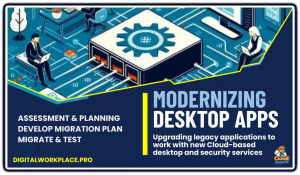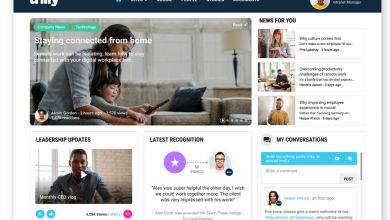Easily Modernize App Delivery: Convert Microsoft App-V to Liquidware FlexApp
How organizations can seamlessly transition from Microsoft App-V to Liquidware FlexApp, modernizing their app delivery strategy in the process.
 In today’s rapidly evolving digital workspace landscape, organizations face increasing pressure to modernize application delivery while maintaining efficiency, security, and user satisfaction.
In today’s rapidly evolving digital workspace landscape, organizations face increasing pressure to modernize application delivery while maintaining efficiency, security, and user satisfaction.
For years, Microsoft App-V has been a staple in application virtualization, enabling IT teams to deliver applications without traditional installation.
However, with App-V approaching its end-of-life (EOL) in 2026 and Microsoft shifting focus to newer technologies like MSIX, businesses must look for future-proof alternatives.
Enter Liquidware FlexApp—a robust application layering solution that not only replaces App-V but also enhances app delivery with greater flexibility, compatibility, and simplicity. This article explores how organizations can seamlessly transition from Microsoft App-V to Liquidware FlexApp, modernizing their app delivery strategy in the process.
The Decline of Microsoft App-V
Microsoft App-V, first introduced in 2006, revolutionized application virtualization by isolating apps from the underlying operating system (OS), reducing conflicts and simplifying deployment.
However, its lifecycle has reached a turning point. The latest version, 5.1, released in 2015, entered extended support in 2018, with full support ending in 2026. While App-V remains integrated into Windows 10 and 11, its future is tied to the lifecycle of specific OS builds, leaving organizations with an uncertain path forward.
MSIX
Microsoft has shifted its attention to MSIX, a modern packaging format designed for Windows apps, and MSIX App Attach, an application layering approach for Azure Virtual Desktop (AVD). However, MSIX adoption has been slow due to limited compatibility (often cited at 30-40% for legacy apps without additional tooling) and restricted support on older Windows versions. For enterprises reliant on diverse application portfolios—including legacy MSI, EXE, and custom apps—MSIX alone falls short.
This gap creates an opportunity for solutions like Liquidware FlexApp to step in, offering a comprehensive, platform-agnostic alternative.
Why Liquidware FlexApp?
Liquidware FlexApp takes a fundamentally different approach from App-V’s virtualization model. Instead of isolating applications in virtual bubbles, FlexApp uses application layering to package apps into portable virtual hard disks (VHDs or VMDKs) that are dynamically “attached” to a Windows session. This method mimics native installation, delivering near-perfect compatibility (over 95% for Windows apps) while keeping base images clean and manageable.
Key advantages of FlexApp over App-V include:
- Broad Compatibility: FlexApp supports virtually any Windows application format—MSI, EXE, MSIX, and even App-V—making it ideal for heterogeneous app portfolios.
- Simplified Management: By separating apps from the OS, FlexApp reduces the number of base images IT teams must maintain, streamlining updates and migrations.
- Dynamic Delivery Options: Apps can be attached at boot, logon, or on-demand via FlexApp’s Click-to-Layer technology, offering unmatched flexibility.
- Active Development: Unlike App-V, FlexApp is actively enhanced with features like FlexApp One (self-contained app executables) and integrations with tools like Microsoft Intune and Citrix Web Studio.
- Conversion Tools: FlexApp provides built-in utilities to convert existing App-V packages into FlexApp layers, easing the transition.
Benefits of the Transition
Switching from App-V to FlexApp delivers immediate and long-term advantages:
- Future-Proofing: With App-V’s EOL looming, FlexApp ensures continuity and scalability as Microsoft’s ecosystem evolves.
- Cost Efficiency: Reduce base image sprawl and IT overhead, cutting management time by up to 50%, as reported by Liquidware users.
- Enhanced User Experience: Faster app load times (no virtual package caching) and instant access improve productivity.
- Security: Features like OAuth integration with Microsoft Entra ID and micro-isolation bolster app security in a Zero Trust framework.
- Flexibility: Support for offline scenarios, multi-session environments (e.g., RDSH, AVD), and diverse platforms ensures adaptability.
Real-World Impact
Consider a mid-sized enterprise with 500 employees, managing 200 applications via App-V across virtual and physical desktops. Post-conversion to FlexApp, they reduce their base images from 10 to 2, deploy updates 10x faster with FastPackaging, and enable remote workers with FlexApp One—all while maintaining 98% app compatibility. This transformation not only modernizes their infrastructure but also positions them to adopt cloud workspaces like AVD or Windows 365 effortlessly.
Conclusion
As Microsoft App-V nears its sunset, Liquidware FlexApp emerges as the superior choice for modernizing application delivery. Its layering technology, conversion tools, and robust feature set empower organizations to move beyond virtualization’s limitations, delivering apps faster, more reliably, and across any Windows workspace.
By converting App-V packages to FlexApp layers, businesses can simplify management, enhance user satisfaction, and future-proof their digital strategy—all with minimal disruption. The time to act is now: embrace FlexApp and redefine how your applications reach users in 2025 and beyond.



